As L&D teams, we have strategies for everything.
Yet, there’s one very important topic that we surprisingly don’t focus much of our strategic attention on - content. And I’m not sure why we don’t!
In a content-driven world, you’d think it would be a core part of the strategy, right?
Let's talk about that.
What is the Learning Content Strategy Maturity Model?
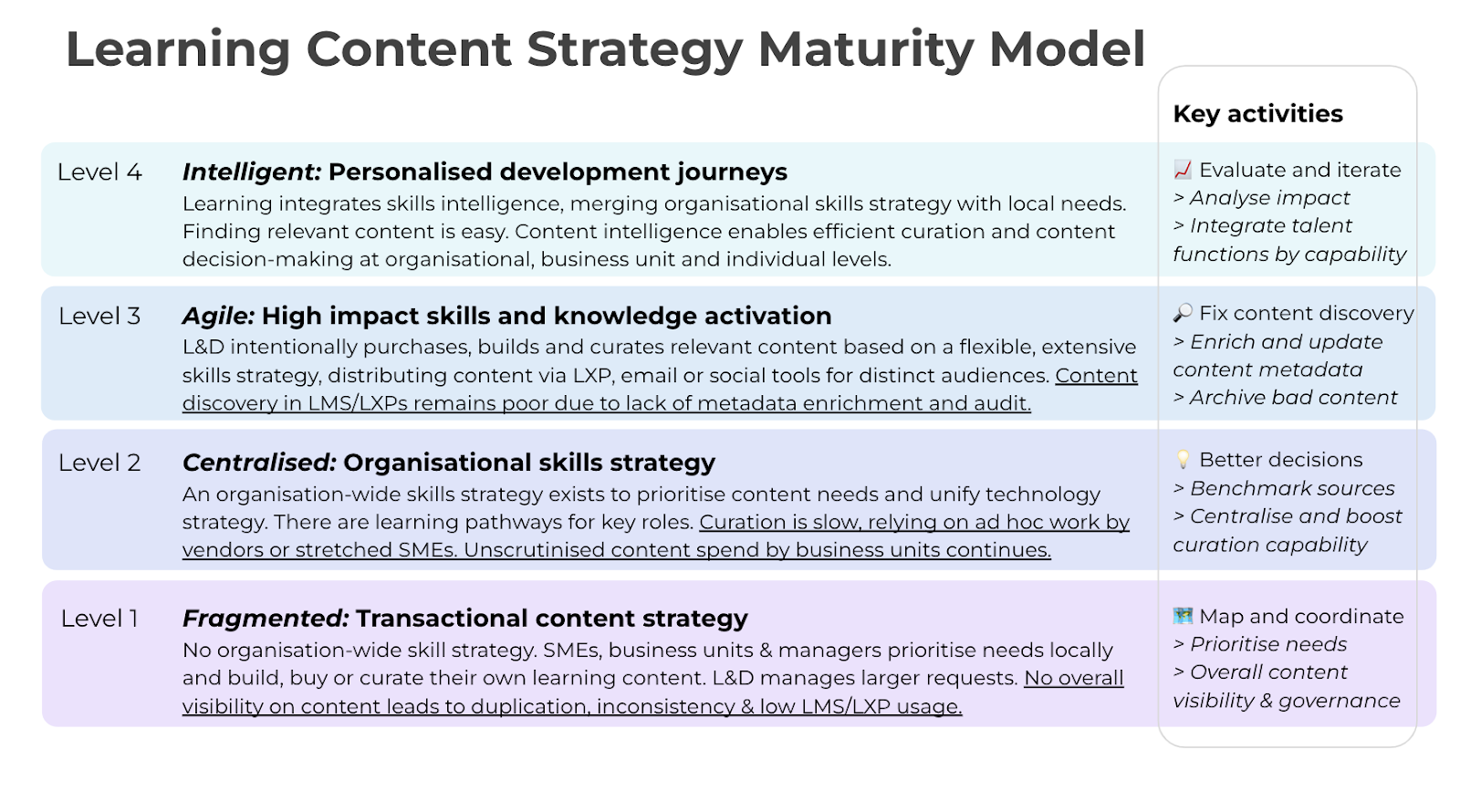
In a nutshell, it’s a simple way for L&D teams to understand if their content is delivering impact or creating chaos.
The better your strategy, the more powerful your content can be for users.
For my fellow Marvel fans out there. Imagine the maturity model like Thanos' lovely golden gauntlet (aka golden glove). The infinity stones he wants to acquire full power are the different levels within the model we can aspire towards. Thus becoming masters of content.

We created the maturity model to provide the L&D industry with a tactical model to benchmark their own content strategy and maturity.
Let’s unpack how you can use this.
Why use the Learning Content Strategy Maturity Model?
I mean, why not?
We’ve defined a problem and this is the solution, folks. Plus, it’s a zero-cost tool!
On a more serious note, we see 3 key benefits to adopting this model in your organisation.
- Benchmarking
The model provides a clear benchmark against which you can assess your team’s capabilities and performance to identify areas for improvement. You can’t know how to improve if you don’t know where you start. - Goal-setting
Even your content needs goals. The maturity model can help you identify what’s working in your content ecosystem and what’s not. Without goals, our content strategies are merely just aspirations. - Alignment
Most importantly, you can align your efforts with business strategy.
This point should not be underestimated.
By focusing on the capabilities most important to your organisation's success, you ensure your investment aligns with overall strategic objectives.
How do I assess my organisation’s Learning Content Strategy Maturity?
Now that we’re all excited by the possibilities, let’s unpack how you can use the model to assess your organisation's maturity level.
We’ve included a short descriptor of how an organisation would typically operate within each level. This gives you a clear view of how to assess your structure. Does the description sound like you? Great, that’s your level!
Next, we want to understand how to improve on your current level.
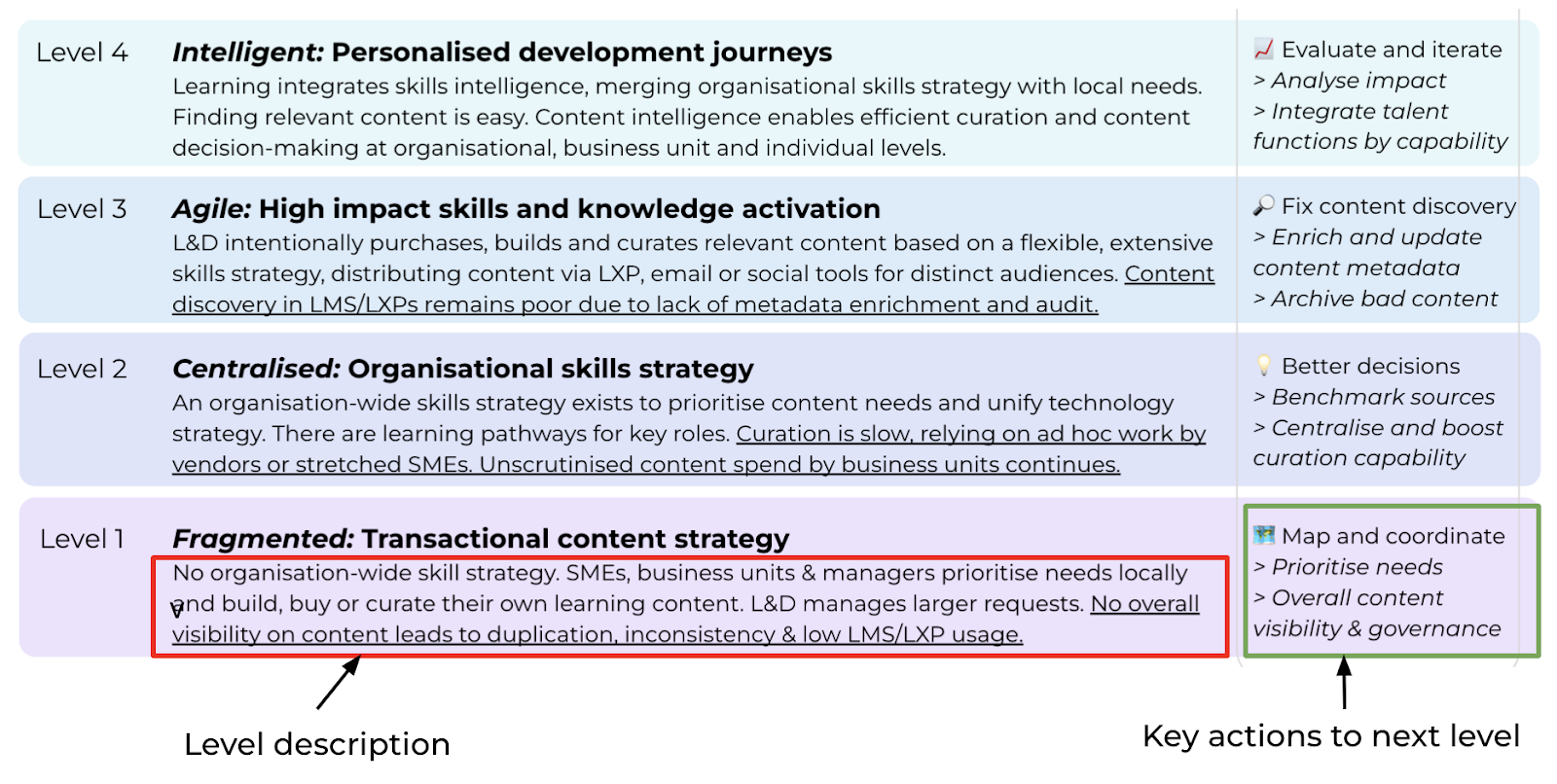
To do this, we’ve laid out key activities that you will need to achieve to move through to the next level. Some are tweaks to what you have and others are larger pieces of work. They all focus on enabling you to scale your content strategy in your specific environment.
No two environments will be the same.
Don’t be alarmed if your level is lower than you expected. 80% of enterprise organisations we work with sit at Level 1 (Fragmented) and Level 2 (Centralised). Our top levels are aspirational for many L&D teams today, but we’re going to help you put a plan in place to get there.
Ok, it’s time to break down our 4 levels to identify:
- The level you are today.
- How to reach the next level.
- Key activities you should focus on.
The Learning Content Strategy Maturity Levels
Level 1 → Fragmented: Transactional content strategy

Typical organisations at this level demonstrate:
- No organisation-wide skill strategy.
- SMEs, business units & managers prioritise needs locally and build, buy or curate their own learning content.
- L&D manages larger requests.
- No overall visibility on content leads to duplication, inconsistency & low LMS/LXP usage.
Key activities
In our entry-level, you have several simple activities you can do to move to level 2.
We call this stage 🗺️ Map and Coordinate.
Here we want to complete two tasks:
- Prioritise needs
- Overall content visibility & governance
Prioritise needs
You won’t get far unless you’re clear on your organisation’s pain points.
To do this, I recommend checking out our “How To Conduct A Performance Focussed Needs Analysis”. You’ll get a step-by-step guide to gathering the data you need with a simple zero-cost template too.
Content visibility and governance
It’s no good having a million pieces of content if:
A) No one knows it exists
B) You have no control and quality measures in place
To fix this, I’d recommend running a skills gap analysis on your current content. That might sound weird but it’s beneficial. Pair this with conducting regular content health checks and my friend, you have a recipe to hit level 2.
Level 2 → Centralised: Organisational skills strategy
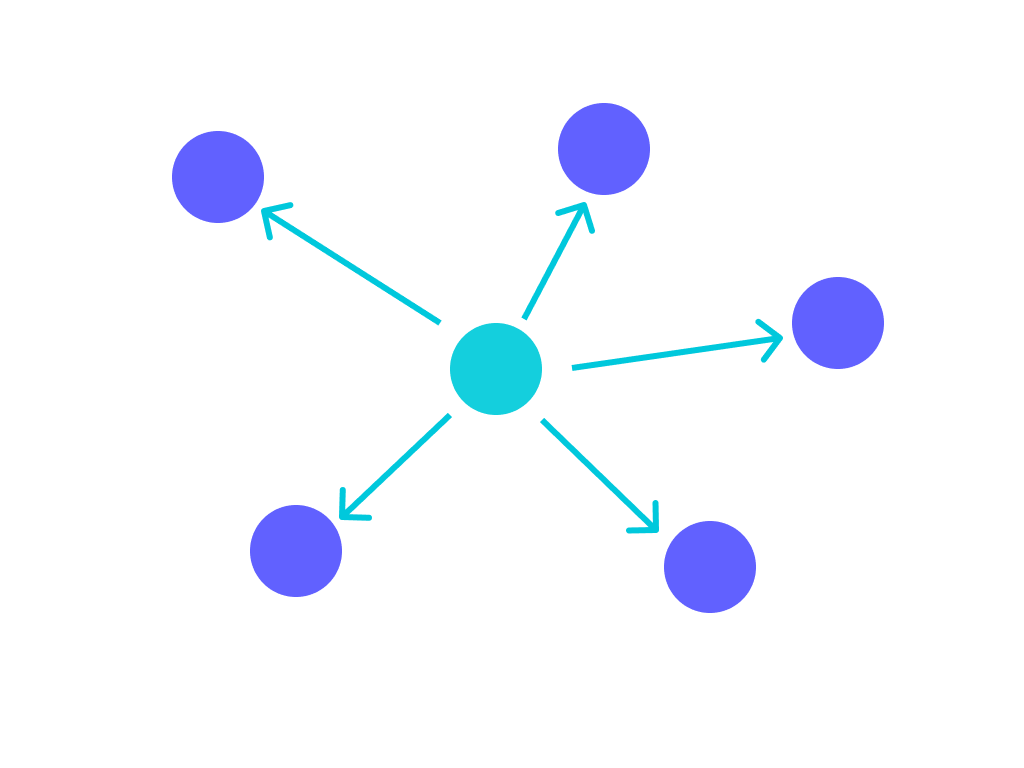
Typical organisations at this level demonstrate:
- An organisation-wide skills strategy exists to prioritise content needs and unify technology strategy.
- There are learning pathways for key roles.
- Curation is slow, relying on ad hoc work by vendors or stretched SMEs.
- Unscrutinised content spend by business units continues.
Key activities
To improve in level 2, we want to get to a stage of being able to make better decisions:
Here we want to complete two tasks:
- Benchmark sources
- Centralise and boost curation capability
Let's talk about the how.
Benchmark sources
Organisations at level 2 know their content spend. Our L&D budgets are often so precious and under constant threat of being depleted. Our CEO, Marc, wrote about his CPQA benchmarking model that we’ve used with enterprise organisations to define a clear cost metric for your content.
Centralise curation capability
You have many ways to do this.
I’d recommend you check out our content curation 101 guide and best curation tips to stoke the fire.
Level 3 → Agile: High impact skills and knowledge activation
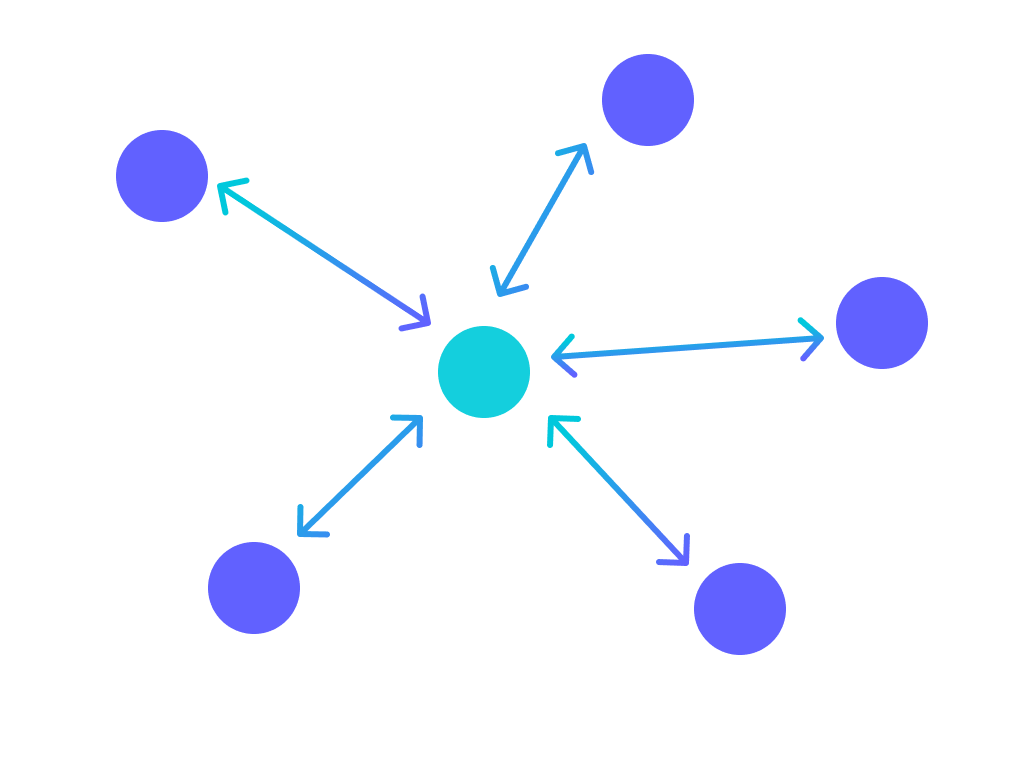
Typical organisations at this level demonstrate:
- L&D intentionally purchases, builds and curates relevant content based on a flexible, extensive skills strategy, distributing content via LXP, email or social tools for distinct audiences.
- Content discovery in LMS/LXPs remains poor due to a lack of metadata enrichment and audit.
Key activities
We’ve moved into the high-performing content strategy range now.
If you’re at this level already, kudos to you friend - you’re doing great!
To join the holy grail of organisations in level 4, you’re gonna need to level up your content discovery efforts.
Here we want to complete two tasks:
- Enrich and update content metadata
- Archive bad content
As we’ve covered already. Content is cool, but if no one knows it exists, what’s the point of it?
This is where discoverability efforts and specifically metadata come into the equation.
For the uninitiated, metadata is simply a way for your LXP to index content. Metadata is made up of elements such as title, date, language, format etc. All important pieces for smooth content discoverability.
The problem lies in the fact that most metadata in your LXP is broken, well, fragmented at best. No need for us to get too dramatic.
We can solve both fragmented content metadata and archiving unhelpful content with a good old-fashioned content health check protocol. Yes, even your content needs a good old doctor check-up.
Level 4 → Intelligent: Personalised development journeys
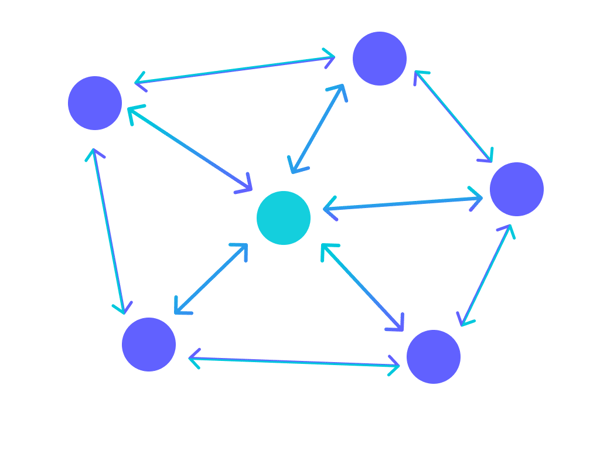
Typical organisations at this level demonstrate:
- Learning integrates skills intelligence, merging organisational skills strategy with local needs.
- Finding relevant content is easy.
- Content intelligence enables efficient curation and content decision-making at organisational, business unit and individual levels.
Key activities
Level 4 is the space where you’ve collected all the infinity stones, I mean content levels, that’s what I meant.
Take pride in your shiny golden glove of sparkling content stones but don’t get complacent. Staying at the top is harder than getting there.
Organisations that stay at this level do one thing really well. They evaluate and iterate constantly.
Here we want to focus on two tasks:
- Analyse impact
- Integrate talent functions by capability
Analyse impact
This is where having access to a smart platform like Filtered can really help (just saying 😉).
Our platform delivers constant insights on the health, adoption and engagement of your content across the entire learning ecosystem. This data enables teams to invest in the right things, improve discoverability and drive LXP adoption.
What organisation doesn’t want that?
Plus, it’s excellent at curating your best content at speed. But, enough about us, let’s talk about what’s next for you.
Find your place and build your empire
There you have it, folks.
Your step-by-step guide to evaluating, building and improving the maturity of your learning content strategy.
The best way to use this tool is alongside your team (and business stakeholders too) to frame where you are today and put a plan of action in place. The framework for your session could look a bit like this:
- Review the maturity framework and evaluate your level
- Discuss how you can improve in the current level
- Discuss a plan of action to get to the next level
We’ve had a great response to the model already.
Fellow L&D practitioner, Jason Thai-Kennedy from Electronic Arts is a big fan:
"I had a look at your content strategy maturity model – and I loved this illustration.
I’d say in our org. (where we have our Learning Strategy employed), we’re at a Level 2 heading towards a Level 3 – where other orgs at EA are Level 1 and we’re working towards improving this as the model suggests.”
Now it’s your turn.
Put these insights into practice and let me know how you get on. You can reach me at ross@filtered.com. I’m excited to hear about your journey with this.

